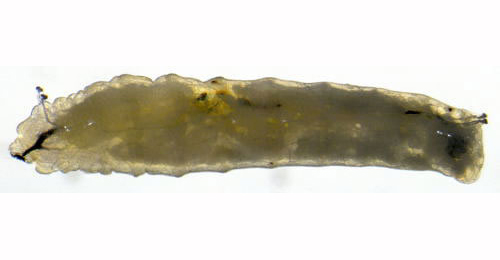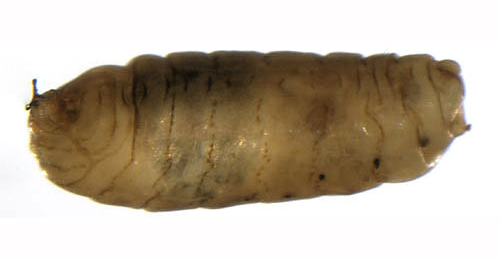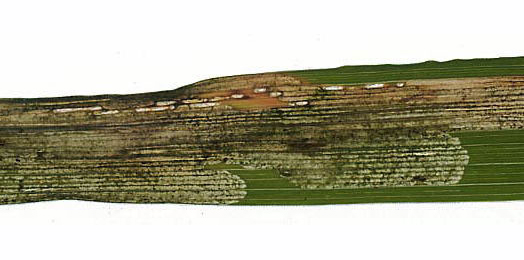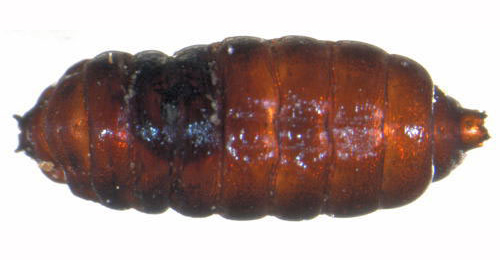|
||||||
|
ELYTRIGIA. [Poaceae] |
|
Four species and three hybrids of Elytrigia (= Agropyron auct. non Gaertn.) are recorded in Britain. The BSBI provide a downloadable plant crib for Elytrigia. Sixteen British miners are recorded on Elytrigia, although not yet all in the British Isles. Nearly 100 British miners or possible miners are recorded on grasses in Britain. A key to the European miners recorded on Elymus including Elytrigia is provided in Bladmineerders van Europa. It is recommended that adults of all miners on grasses be reared to be certain of their identity. |
Key for the identification of the known mines of British |
|||
Note: Diptera larvae may live in a corridor mine, a corridor-blotch mine, or a blotch mine, but never in a case, a rolled or folded leaf, a tentiform mine or sandwiched between two more or less circular leaf sections in later instars. Pupation never in a cocoon. All mining Diptera larvae are leg-less maggots without a head capsule (see examples). They never have thoracic or abdominal legs. They do not have chewing mouthparts, although they do have a characteristic cephalo-pharyngeal skeleton (see examples), usually visible internally through the body wall. The larvae lie on their sides within the mine and use their pick-like mouthparts to feed on plant tissue. In some corridor miners frass may lie in two rows on alternate sides of the mine. In order to vacate the mine the fully grown larva cuts an exit slit, which is usually semi-circular (see Liriomyza huidobrensis video). The pupa is formed within the hardened last larval skin or puparium and as a result sheaths enclosing head appendages, wings and legs are not visible externally (see examples). See Key to non-Diptera. |
|||
1# > ? Leaf-miner: Details of mine unknown. Probably the larva mines for a few days only, and afterwards lives as a stem borer. |
|||
|
|||
Cerodontha inconspicua (Malloch, 1913) [Diptera: Agromyzidae] |
|||
1# > ? Leaf-miner: Details of mine unknown. Pupation external (Spencer, 1972b: 52). Pupation external. |
|||
|
|||
Liriomyza phryne Hendel, 1931 [Diptera: Agromyzidae]. |
|||
1a > Leaf miner: Leaf-mine normally short and broad (Spencer, 1976: 97). According to Hering (1957) initially the larva does not feed towards the apex of the leaf. Pupation external (Spencer, 1976: 97). The shallow, whtish mine starts (not very close to the base of the lamina) as a fine ascending corridor. This is overrun when the direction alternates, and the mine quickly widens. The final mine is characteristically short; often not the full width of the leaf is used. Frass in big black grains, never greenish. Pupation outside the mine. |
|||
|
|||
Agromyza ambigua Fallén, 1823 [Diptera: Agromyzidae]. |
|||
1b > Leaf-miner: Larvae feeding singly, forming a long, widening mine on the upper surface of the leaf, which is generally limited to one side of the leaf. Pupation external, puparium glued to the leaf near the end of the mine (Spencer, 1976: 128). Broad corridor, generally beginning near the leaf margin or close to the leaf tip. Most of the times the mine remains at one side of the midrib. The mine is upper-surface, but has some full depth, translucent spots here and there. Frass in rather regularly scattered grains. Pupation outside the mine. According to Dempewolf (2004a) only the male genitalia enable a reliable discrimination from A. abipennis and A. graminicola. |
|||
|
|||
Agromyza nigripes Meigen, 1830 [Diptera: Agromyzidae]. |
|||
1c > Leaf miner: The young larva first feeds towards the apex of the leaf, later turning and feeding downwards. Several larvae can occur together in a single leaf. Pupation external (Spencer, 1976: 130). Upper-surface, greenish, gradually widening corridor, at first running towards the leaf tip, then reverses. Through fusion of several mines the final mine is often communal. Frass in backish green grains, often washed out. Pupation outside the mine. Puparium reddish brown |
|||
|
|||
|
|||
|
|||
Agromyza nigrociliata Hendel, 1931 [Diptera: Agromyzidae]. |
|||
1d > Leaf-miner: Larvae feed singly, forming greenish mine, initially running towards apex of leaf before turning back down and developing into a broad blotch. Puparium reddish brown. |
|||
|
|||
Agromyza rondensis Strobl, 1900 [Diptera: Agromyzidae]. |
|||
1e > Leaf-miner: Larva feeds mainly in the leaf sheaths. The short mines which may be formed in the leaf blade may be easily overlooked. Pupation internal (Spencer, 1976: 178). Mine begins as a narrow, usually upper-surface, occasionally lower-surface or interparenchymatous corridor in the blade, that descends towards the ligule, thence continues into the leaf sheath, generally on its inside. Usually only one mine per leaf. Puparium in a puparial chamber at the margin of the leaf sheath. Neither mine nor larva can be distinguished from that of C. fulvipes that, as far as is known, only feeds on Poa trivialis. |
|||
|
|||
Cerodontha denticornis (Panzer, 1806) [Diptera: Agromyzidae]. |
|||
1f > Leaf-miner: A lower surface mine. Pupation normally in the ground (Spencer, 1976: 202). Broad, usually lower-surface corridor in the blade, generally first rising, then descending. Mostly one larva in a mine, but sometimes several mines on a leaf may merge. Frass in grains that gradually become both larger and more widely spaced. Pupation outside the mine. |
|||
|
|||
Cerodontha flavocingulata (Strobl, 1909) [Diptera: Agromyzidae]. |
|||
1g > Leaf-miner: Broad elongated mine; the form is dependent of the leaf form of the host plant. Frass green. Usually a number of larvae together in a mine. Pupation in the mine. |
|||
|
|||
Cerodontha incisa (Meigen, 1830) [Diptera: Agromyzidae]. |
|||
1h > Leaf-miner: A linear mine running towards the apex of the leaf and this can widen and become almost blotch-like. Pupation internal. Puparium brownish-black |
|||
|
|||
Cerodontha lateralis (Macquart, 1835) [Diptera: Agromyzidae]. |
|||
1i > Leaf-miner: Broad lower surface mine which generally starts at the leaf apex.The mine is somewhat irregular in depth. Frass in irregular black-green, frequently melted grains, mostly along the edges of the mine. Larva solitary. Pupation generally internal. |
|||
|
|||
Cerodontha muscina (Meigen, 1830) [Diptera: Agromyzidae]. |
|||
1j > Leaf-miner: Normally several larvae feed together. Pupation in the mine. Puparium shining black (Spencer, 1976: 198). Broad elongated blotch. Frass greenish. Larvae generally communal. Pupation within the mine. The black puaria are individially anchored within the mine with a silken thread attached at their rear end. Distinguishable from C. incisa only by means of the larva. |
|||
|
|||
Cerodontha pygmaea (Meigen, 1830) [Diptera: Agromyzidae]. |
|||
1k > Leaf-miner: Upper-surface corridor, generally in the upper half of the blade, running up to the leaf tip, usually occupying more then half the width of the leaf. Frass in green stripes at either side of the corridor. Never more than one larva in a mine. Puparium within the mine, metallic black, not anchered with a string of silk. |
|||
|
|||
Cerodontha superciliosa (Zetterstedt, 1860) [Diptera: Agromyzidae]. |
|||
1l > Leaf-miner: Long, narrow, whitish mine. Pupation internal (Spencer, 1976: 453); anterior spiracles projecting through the epidermis. Whitish, upper-surface, rather narrow corridor with comparatively large frass grains that are laying further apart than their diameter. Pupation within the mine. The anterior spiracles of the orange-brown puparium penetrate the epidermis. |
|||
 Chromatomyia nigra larva, lateral Image: © Willem Ellis (Bladmineerders van Europa) |
|||
 Chromatomyia nigra pupa, lateral Image: © Willem Ellis (Bladmineerders van Europa) |
|||
|
|||
Chromatomyia nigra (Meigen, 1830) [Diptera: Agromyzidae]. |
Key for the identification of the known mines of British |
Note: The larvae of mining Coleoptera, Hymenoptera and Lepidoptera may live in a corridor mine, a corridor-blotch mine, a blotch mine, a case, a rolled or folded leaf, a tentiform mine or sandwiched between two more or less circular leaf sections in later instars. Larva may pupate in a silk cocoon. The larva may have six legs (although they may be reduced or absent), a head capsule and chewing mouthparts with opposable mandibles (see video of a gracillarid larva feeding). Larvae of Hymenoptera and Lepidoptera usually also have abdominal legs (see examples). Frass, if present, never in two rows. Unless feeding externally from within a case the larva usually vacates the mine by chewing an exit hole. Pupa with visible head appendages, wings and legs which lie in sheaths (see examples). |
1# > Leaf-miner: Details unknown.Probably the larva mines for a few days only, and afterwards lives as a stem borer. |
|
Ochsenheimeria urella Fischer von Röslerstamm, 1842 [Lepidoptera: Ypsolophidae]. |
1b > Leaf-miner and Stem-borer: The first instar lave mines in a leaf; after that it lives as a stem borer. |
|
Ochsenheimeria vacculella Fischer von Röslerstamm, 1842 [Lepidoptera: Ypsolophidae]. |
| Last updated 04-Jul-2019 Brian Pitkin | ||


